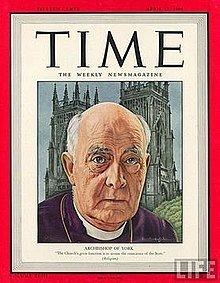Installed 11 June 1942 Term ended 6 February 1955 | Birth name Cyril Forster Garbett Consecration 1919 Name Cyril Garbett | |
 | ||
Education Keble College, Oxford, Ripon College Cuddesdon, Portsmouth Grammar School | ||
Funeral of archbishop of york dr cyril garbett
Cyril Forster Garbett (6 February 1875 – 31 December 1955) was an Anglican bishop and author. He was successively the Bishop of Southwark, the Bishop of Winchester and the Archbishop of York from 1942 to 1955.
Contents
- Funeral of archbishop of york dr cyril garbett
- Archbishop of york dr cyril garbett in berlin 1949
- Early life
- Ordained Ministry
- Archbishop of York
- Final years
- References
Archbishop of york dr cyril garbett in berlin 1949
Early life
Garbett was born in the village of Tongham in Surrey, next to Aldershot in Hampshire, the son of the vicar of Tongham. At the age of 11, he was sent to Portsmouth Grammar School and then to Keble College, Oxford, in 1894. After this, he went to Cuddesdon Theological College to study theology and prepare for ordination.
Ordained Ministry
Garbett was ordained in 1899 as a deacon and was sent to be a curate of St Mary's Portsea, where he was ordained to the priesthood in 1901 and remained until 1919, after 1909 as its vicar. In 1911 he was joined at Portsea by the newly ordained George Armitage Chase, who would later serve Garbett after his ordination to the episcopate, as examining chaplain.
Garbett was consecrated as the Bishop of Southwark by Randall Davidson, Archbishop of Canterbury, at St Paul's Cathedral on St Luke's day (18 October) 1919 and remained in this position until his translation as the Bishop of Winchester in 1932 before, in 1942, becoming the Archbishop of York.
Archbishop of York
Garbett was a popular public figure, especially as a pastoral bishop, famous for trudging the length of his dioceses with his walking stick, visiting both clergy and lay people in the towns he passed through. Although personally warm, he had a reputation as a firm disciplinarian with clergy in his dioceses.
Politically and theologically, he is best seen as a transitional figure between the Edwardian and modern periods of the Church of England. A staunch nationalist and royalist, he held an erastian view of the Church of England clearly as a national church, and he held strongly traditional views of issues such as family relationships, sexual morality, and corporal punishment.
On the other hand, Garbett belonged to the generation which was comfortable with the idea of diversity in the Church of England and had little patience for High Church versus Low Church struggles. He was a pioneer of the Ecumenical Movement and, during and after the Second World War, travelled extensively, including to Communist Bloc countries. Although generally perceived as leaning rightwards politically, he was comfortable with the welfare state which emerged during his archiepiscopate.
Garbett's trip to Moscow in September 1943, at the invitation of the Moscow Patriarchate, was greeted by the newly installed Moscow Patriarch Sergiy (Stragorodskiy), was used by Joseph Stalin's propaganda machine to spread falsehoods about religious freedom in the USSR: on 24 September, the New York Times quoted Garbett as stating that "he was convinced that there was the fullest freedom of worship in the Soviet Union". However, during the Cold War, Garbett denounced Communism as un-Christian and actively supported the British government line.
On 17 April 1944, Garbett appeared on the cover of TIME magazine after he had been persuaded by the British Ministry of Information to go to the United States to discuss religious freedom in Russia. During this visit, he said that "Marshal Stalin, being a great statesman, has recognised the power of religion."
Garbett's visit to Dublin, where he met President De Valera, was considered significant.
Garbett sat in the House of Lords for many years as a Lord Spiritual and, as an erastian, he took his duties very seriously. In a notable statement made to the House of Lords in 1942, Garbett denounced Nazi Germany's extermination of Polish Jews, calling it "the deliberate and cold-blooded massacre of a nation."
On his retirement, Garbett was offered and accepted a hereditary barony, but he died before this could be legally created. It is thought he was to take the title Baron Garbett of Tongham.
Final years
Garbett continued to work into his late seventies, which eventually took its toll. On his eightieth birthday, 6 February 1955, he retired from active ministry and was created a Knight Grand Cross of the Royal Victorian Order. Later that year, he underwent surgery and spent the last months of his life in a convalescent home where he continued to write and correspond until his death, on 31 December 1955.
